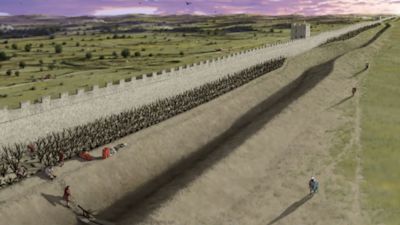Why did the Romans build Hadrian's Wall?

1,900 years ago, something remarkable happened...
Construction began on a wall spanning the entire width of freshly conquered Britannia - 73 miles of stone piled up to six metres high.
The order to do so likely came from the Roman Emperor Hadrian directly. He visited the northernmost reaches of his empire in 122 AD and, according to his 4th-century biographer, was intent on barrier-building.
After roughly six years of toil, a wall stretched between what we know as Bowness-on-Solway in Cumbria and Wallsend on Tyneside.
Almost two millennia after that, historians are still puzzling over precisely why. Why did the Romans build Hadrian's Wall and was it a success?
Hadrian's Wall - A Brief Timeline
55 BCE - 54BCE: Julius Caesar expedition to Britain
43 AD: South Britain becomes part of the Roman Empire
117 AD: Hadrian becomes Emperor
122 AD: Hadrian visits Britain. Construction begins on the Wall.
126-127 AD: The Wall is completed
142 AD: The Antonine Wall built under Antoninus Pius to the north of Hadrian's Wall.
180 AD: Tribes cross the Wall during a major battle
410 AD: The Romas withdraw from Britain amid troubles on the continent
19th century: The conservation movement begins to protect the ruins from being exploited
1987: Hadrian's Wall is designated a UNESCO World Heritage Site.
What was Hadrian's Wall like?
As with all things Hadrian's Wall, there is considerable academic debate surrounding precisely what the structure looked like back in the 2nd century.
But researchers widely agree that it was built by roughly 15,000 Roman legionaries, tasked not only with transporting and stacking stone but also digging a large ditch in front of it.
According to English Heritage, "long the line of the Wall were turrets, small fortlets known as milecastles, and forts for larger garrisons.
"These were all linked by a military road. Running parallel a little further to the south were two large earthworks either side of a ditch called the vallum."
Hadrian's Wall was more than just a wall.
At each Roman mile mark, a gate was installed and protected by a small guard post called a milecastle. Positioned along the Wall were also over 15 larger forts - housing as many as 600 men - and numerous observation towers.
The Wall clearly expended considerable manpower to construct and maintain. Why all the trouble?
Why was Hadrian's Wall built?
To some, the answer is obvious. Hadrian's Wall was built to protect the Roman Empire from barbarian hordes to the north.
This was the conclusion reached in the Historia Augusta, a 4th-century collection of Roman biographies.
"And so, having reformed the army quite in the manner of a monarch, he set out for Britain, and there he corrected many abuses and was the first to construct a wall, eighty miles in length, which was to separate the barbarians from the Romans," it reads.
But to others, the reasons may have been more complex, and many question the threat posed by the tribes of modern-day Scotland. They suggest the following other possible reasons for building the Wall:
To keep people in as the Romans established themselves on the island
To form a customs barrier
To give legionnaires and auxiliaries something to do
Did Hadrian's Wall work?
Regardless of how multiplex the reasons behind constructing the Wall were, it is highly likely that defence was on Hadrian's mind.
But for how long did it work as a defensive structure and when did it begin to crumble into ruin?
After Hadrian's 138 AD death, Emperor Antoninus Pius decided to move the frontier northwards, leaving the Wall and starting construction on a turf barrier known as the Antonine Wall in 142 AD.
This was abandoned after roughly twenty years as the Romans retreated to Hadrian's. But in the late 2nd century, the Wall appears to have been breached during a major conflict with so-called barbarians.
For the next 250 years, the generals steadily added fortifications and the Wall was turned into a hub of activity. This appears to have all come to an end when the Romans returned to continental Europe amid external attacks on the Empire and internal strife.
A lack of historical records means what happened after the Romans is somewhat unclear. The Wall may have continued functioning in some capacity for some time, but it came to be plundered throughout the Middle Ages - effectively used as a quarry for other projects such as the building of castles and churches.
This continued until the conservation movement in the 19th century, when historians began campaigning to preserve the Wall for the purpose of heritage.
In 1987, Hadrian's Wall is designated a UNESCO World Heritage Site.